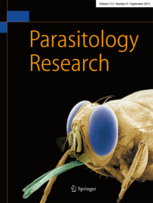Ver ítem
- xmlui.general.dspace_homeCentros e Institutos de InvestigaciónCICVyA. Centro de Investigación en Ciencias Veterinarias y AgronómicasInstituto de GenéticaArtículos científicosxmlui.ArtifactBrowser.ItemViewer.trail
- Inicio
- Centros e Institutos de Investigación
- CICVyA. Centro de Investigación en Ciencias Veterinarias y Agronómicas
- Instituto de Genética
- Artículos científicos
- Ver ítem
Genetic variation and heteroplasmy of Varroa destructor inferred from ND4 mtDNA sequences
Resumen
Varroa destructor, a parasitic mite of the western honey bee, Apis mellifera L., is a serious threat to colonies and beekeeping worldwide. Population genetics studies of the mite have provided information on two mitochondrial haplotypes infecting honey bee colonies, named K and J (after Korea and Japan, respectively, where they were originally identified). On the American continent, the K haplotype is much more prevalent, with the J haplotype only
[ver mas...]
Varroa destructor, a parasitic mite of the western honey bee, Apis mellifera L., is a serious threat to colonies and beekeeping worldwide. Population genetics studies of the mite have provided information on two mitochondrial haplotypes infecting honey bee colonies, named K and J (after Korea and Japan, respectively, where they were originally identified). On the American continent, the K haplotype is much more prevalent, with the J haplotype only detected in some areas of Brazil. The aims of the present study were to assess the genetic diversity of V. destructor populations in the major beekeeping region of Argentina and to evaluate the presence of heteroplasmy at the nucleotide level. Phoretic mites were collected from managed A. mellifera colonies in ten localities, and four mitochondrial DNA (mtDNA) regions (COXI, ND4, ND4L, and ND5) were analyzed. Based on cytochrome oxidase subunit I (COXI) sequencing, exclusively the K haplotype of V. destructor was detected. Furthermore, two sub-haplotypes (KArg-N1 and KArg-N2) were identified from a variation in ND4 sequences and the frequency of these sub-haplotypes was found to significantly correlate with geographical latitude. The occurrence of site heteroplasmy was also evident for this gene. Therefore, ND4 appears to be a sensitive marker for detecting genetic variability in mite populations. Site heteroplasmy emerges as a phenomenon that could be relatively frequent in V. destructor.
[Cerrar]

Fuente
Parasitology Research 119 (2) : 411-421 (Febrero 2020)
Fecha
2020-02
Editorial
Springer
ISSN
1432-1955
Documentos Relacionados
Formato
pdf
Tipo de documento
artículo
Proyectos
(ver más)
INTA/PNAPI-1112042/AR./Estrategias multidisciplinarias para mitigar el efecto del nuevo contexto ambiental y productivo sobre la colmena.
Palabras Claves
Derechos de acceso
Restringido
 Excepto donde se diga explicitamente, este item se publica bajo la siguiente descripción: Creative Commons Attribution-NonCommercial-ShareAlike 2.5 Unported (CC BY-NC-SA 2.5)
Excepto donde se diga explicitamente, este item se publica bajo la siguiente descripción: Creative Commons Attribution-NonCommercial-ShareAlike 2.5 Unported (CC BY-NC-SA 2.5)

